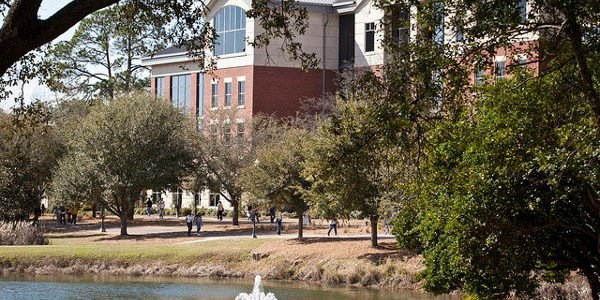Atop the list, as compiled Monday by the New York Times, is Ames, Iowa, the home of Iowa State University. No. 10 is Grand Forks, N.D., where the University of North Dakota is located. Two others on the list are Auburn/Opelika, Ala., (Auburn University) and Oxford, Miss. (Ole Miss).
Others include two Georgia college towns: Milledgeville, where Georgia College is located, which is No. 5. It’s followed at No. 6 by Statesboro, the home of Georgia Southern University. The Times lists the metro areas by number of new infections per population.

Georgia College
Across the United States, the reopening of college campuses has led to thousands of COVID-19 cases. Younger people rarely develop serious symptoms from the virus, and the danger from campus outbreaks may be less to the students themselves and more to vulnerable people in their families, among college workforces and in surrounding communities, the New York Times reported.
“The third wave is going to be these kids,” Dr. George Rutherford, an epidemiologist at the University of California, San Francisco, who advises universities and other major institutions about the coronavirus, told the Times. The first wave, he said, centered on New York City and the second on the South and the Southwest.
“Anytime people are gathering, going to parties, that is definitely presenting a risk,’’ Michael Hokanson, a spokesman for the public health district that includes Milledgeville and Georgia College, told GHN on Monday. “There’s an influx of people in the town surrounding the college.’’
He said that when a positive test result is reported, the case gets listed geographically based on the address that a student gives – whether it’s the student’s hometown, an off-campus apartment or a campus address.
Hokanson urged people to follow social distancing and mask-wearing guidelines.
“It’s a community effort. It’s never a time to relax [but] people have gotten lax.’’
The jump in COVID cases in Bulloch County and Statesboro track with the reopening of the university, said Isaac Chun-Hai Fung, a Georgia Southern epidemiology professor.

Georgia Southern
Georgia Southern’s Health Services test only students who have symptoms of COVID, Fung said. Asymptomatic students must go to the general Public Health system to get tested. Some of them, he said, will pass along the disease.
“In my opinion, we will see more and more cases,’’ Fung said.
Most of the colleges in the University System of Georgia don’t have the testing resources needed to curb the transmission, unlike at large institutions such as the University of Georgia and Georgia Tech, he added.
Georgia College in Milledgeville has reported nearly 550 student cases since the beginning of August.
The college’s College Chapter of United Campus Workers of Georgia organized a “die-in” Friday morning at the campus to protest what some students, employees and parents said was poor planning by university leadership.

Georgia College didn’t test students, faculty or staff before they returned to campus earlier this summer and there have been complaints about a lack of social distancing and limited virtual education options, the Macon Telegraph reported.
In a recent email to students, Georgia College President Steve Dorman linked the spike in cases in August to off-campus parties and gatherings, WMAZ reported.
“This activity is totally unacceptable and needs to stop immediately,” Dorman said. “It endangers the safety of others and threatens to prevent the desire of most of you to remain together here at GC for the semester.”
“Once again, I appeal to you and firmly ask that you refrain from organizing or going to parties and other large gatherings where social distancing and mask wearing may be compromised,” he said.
Campus social groups practice caution
Statesboro is the main city in Bulloch County, which has recorded hundreds of new cases in the past week.
Grice Connect reported that Bulloch County broke a record Friday, reporting 133 positive cases. That was double Thursday’s record setting day of 64. The county added 122 more cases Sunday.

Bulloch County
Georgia Southern, on a website, reported 129 confirmed cases, and another 379 individuals who have self-reported a positive test for the virus.
The college, on the website, said that the rise in positive cases was “anticipated.’’
“As an institution of nearly 27,000 students and 3,350 employees, positive reports represent a very small proportion of our overall university population,’’ the website stated. “These cases are primarily concentrated within the student population on the Statesboro campus. While we have been pleased with how the university community is complying with public health guidelines on our campuses, we must remain vigilant in our efforts if we want to continue the semester as we have started.’’
The Georgia Southern football team last week suspended practice after positive cases were reported.

Georgia Southern football practice
And fraternity and sorority life councils, which help govern what’s known as the campus Greek community, voted last week to refrain from hosting social events and moved in-person organizational meetings and events to a virtual format through Oct. 1.
“As a Greek woman, I know the tremendous impact Greek leaders have on our campus communities,” said Shay Little, Georgia Southern’s vice president for student affairs. “The collective action taken by our councils is exactly the bold leadership we need to slow the spread of COVID-19. I am proud of the Greek community’s leadership and vision to set high expectations to keep our communities safe and healthy.”
Little pointed out that planning also comes with personal responsibility.
“Faculty and staff are working diligently to keep our campuses healthy and safe,” Little said. “The six councils have now stepped up and lived true to our fraternal values by setting expectations for behaviors to support a safe and healthy campus environment. Each of us must do our part to keep our community safe.”




